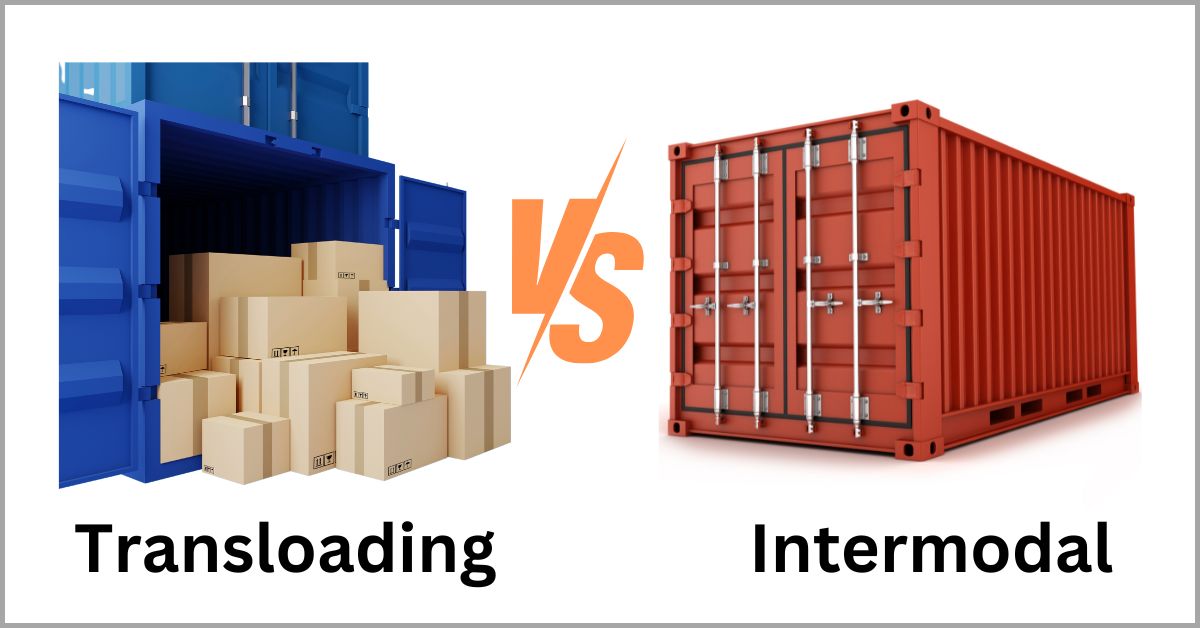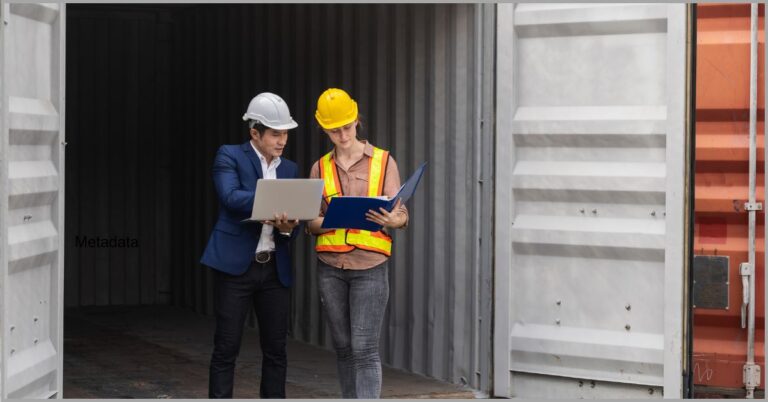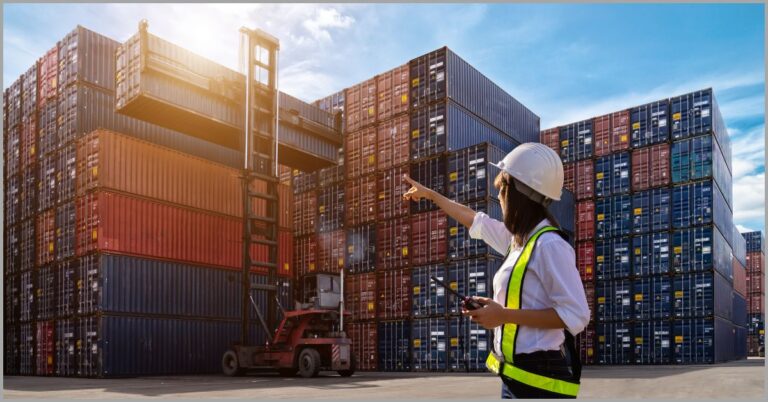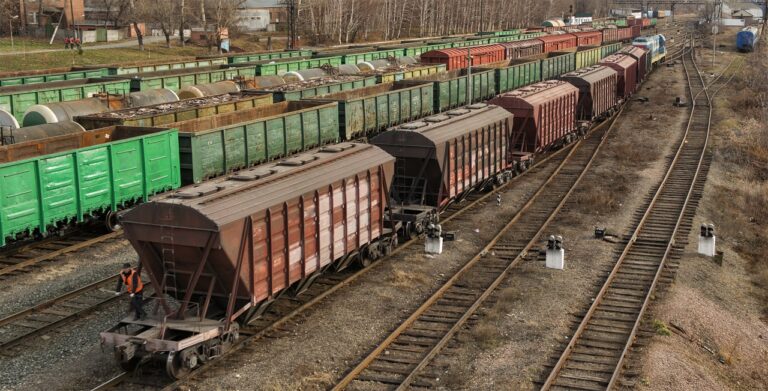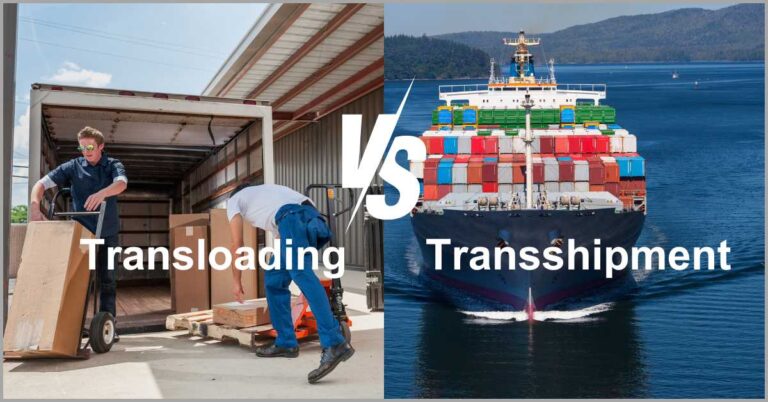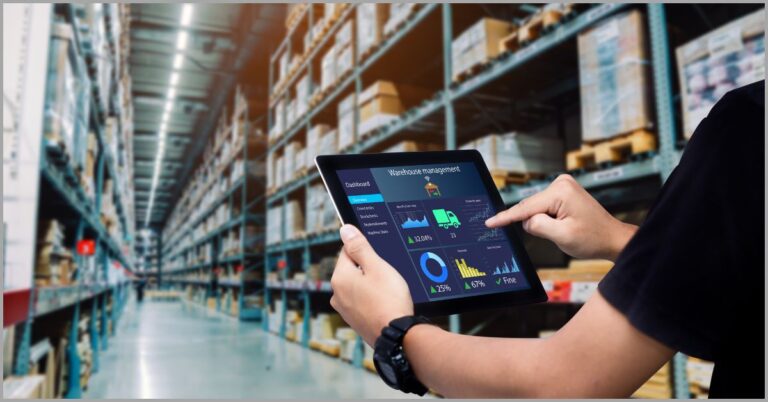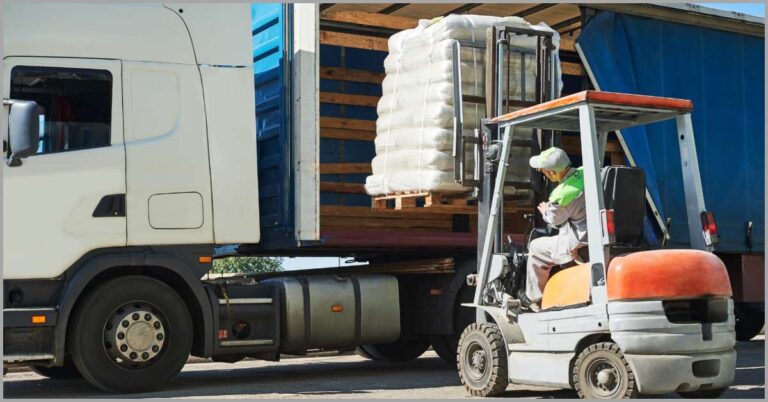Transloading vs Intermodal: 10 Key Differences Between You Must Know in 2024
Can’t decide between transloading vs intermodal?
The intermodal and transload business industry are similar but key differences exist.
If you choose a shipping strategy that’s unideal for your current shipping needs, your business may experience delays and supply chain disruptions.
In 2023, approximately 36% of freights were delayed, according to a Statista study. This was partly because of poor shipping intelligence and strategies.
Both transloading and intermodal are shipping methods where you exchange goods from one form of transportation to another. But there are vital differences you need to understand about transloading vs intermodal if you’re to achieve your shipping goals.
This knowledge will help you choose the right shipping strategy and even combine them when suitable to get the best shipping outcomes and improve your supply chains.
In this article, we’ll discuss key differences between transloading vs intermodal you must know in 2024 to help your business improve shipping cost-efficiency.
Let’s get started.
What is transloading and intermodal shipping?
I) Transloading
So what is transloading?
It is the process of switching goods from one form of transport to another by loading and unloading cargo or vice versa.
For example, if you run a transloading facility, you can receive cargo initially by truck. Then you can offload this cargo from trucks to rail cars. with rail transporting it for the next leg of the journey. This is an example of transloading.
Transloading is a practice that we can trace back to the 19th century. However, its popularity skyrocketed during the COVID-19 pandemic because it helped to ease container backlog quickly by enabling alternative choices of transportation.
It’s especially suitable when you want to ship goods of non-standard shapes and sizes like bulk materials, timber, and commodities goods that can prove very space-inefficient if transported within containers.
II) Intermodal
What is intermodal shipping?
On the other hand, intermodal shipping is the transfer of containerized goods from one form of transport to another. Whereas transloading transfers individual units of goods, intermodal involves switching entire shipping containers without opening them up.
Let’s say you’ve ordered merchandise for your store from China. The manufacturer will contract a shipper for transportation, and they will in turn collect your goods.
Afterward, the shipper will load all the merchandise into an empty intermodal container and seal it. They’ll use a combination of sea, rail, and local trucking until they get it to your store in California. This offers a great example of intermodal shipping.
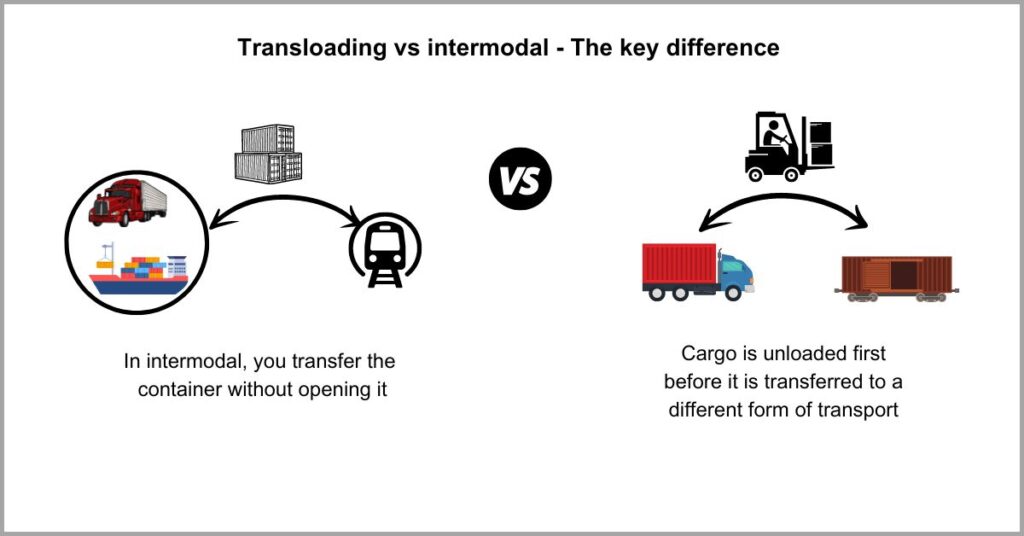
This practice traces back to the 18th century, and it was catalyzed by the invention of containerization by Malcolm McLean,
Intermodal shipping is ideal when you’re dealing with cargo like oil, petroleum, or a consignment headed for one recipient that’s unlikely to be opened up again.
Differences between transloading vs intermodal
1. Process flow
Intermodal shipping entails a larger process.
First, the shipper receives an empty intermodal container from the shipper. They’ll then load it up with cargo and move it to the next means of transport, with transportation modes often exchanged several times during the journey.
Generally, intermodal shipping tends to have more changeover of goods since it tends to happen over long distances, thereby attracting more complex logistics.
A report by Inspectorio established that 40% of supply chain managers struggle with efficiency, data analysis, and decision-making. In an intermodal setting, these challenges can be greatly compounded given the many logistical factors it involves.
There are more transport nodes to deal with the longer the intermodal shipping route is, and therefore this means more steps in logistics and more paperwork to consider.
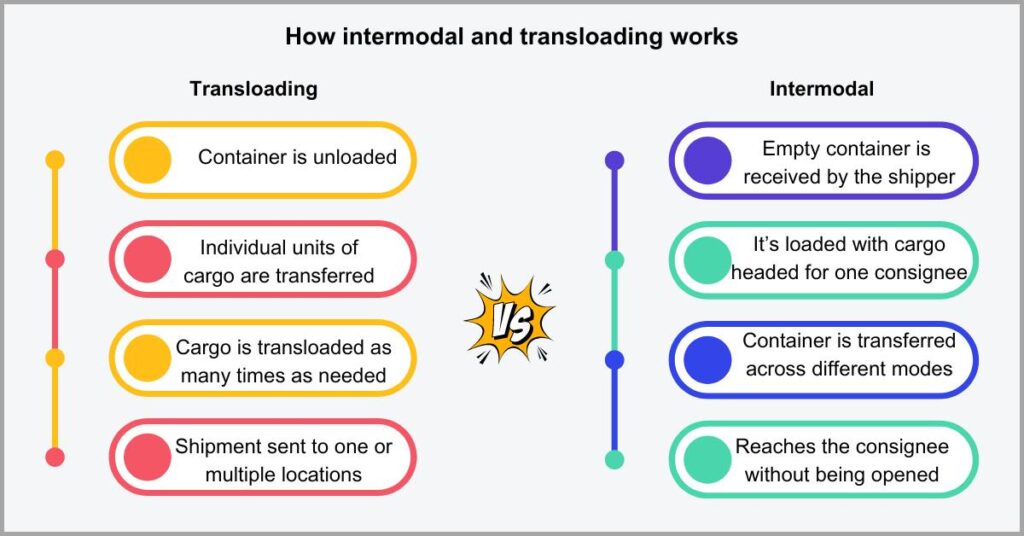
What’s the process like during transloading?
Here, you’ll receive cargo at a supply chain transfer point, typically a transload facility. This facility will unload goods from the initial container, rail car, or truck, and then load them into another means of transportation.
This is an excellent strategy as it can improve transloading ROI, by enabling you to consolidate orders with different shippers.
As a result, even if you have a lower shipment volume, you can join forces with other parties to merge orders and use the same means of transportation. This helps your business to realize huge cost-saving benefits.
Due to the fact the processes involved are fewer and much more small-scale, transloading tends to have fewer logistics challenges compared to intermodal.
2. Flexibility and versatility
So how are goods handled in intermodal shipping?
In this type of shipping, your goods are stored in an intermodal container, which is not opened at any point during the journey. If there’s a need to switch it between different modes of transport, you’ll transfer the entire container as it is.
While this reduced handling lowers the risk of damage, it can also lead to massive losses because the entirety of your cargo can get lost in one go.
In fact, approximately 1,566 containers are lost at sea annually, going by a WSC study. They determined that most of these incidents resulted from human factors like inaccurate weight declaration & poor packing.
So intermodal shipping can be a risky shipping strategy if you do it incorrectly.
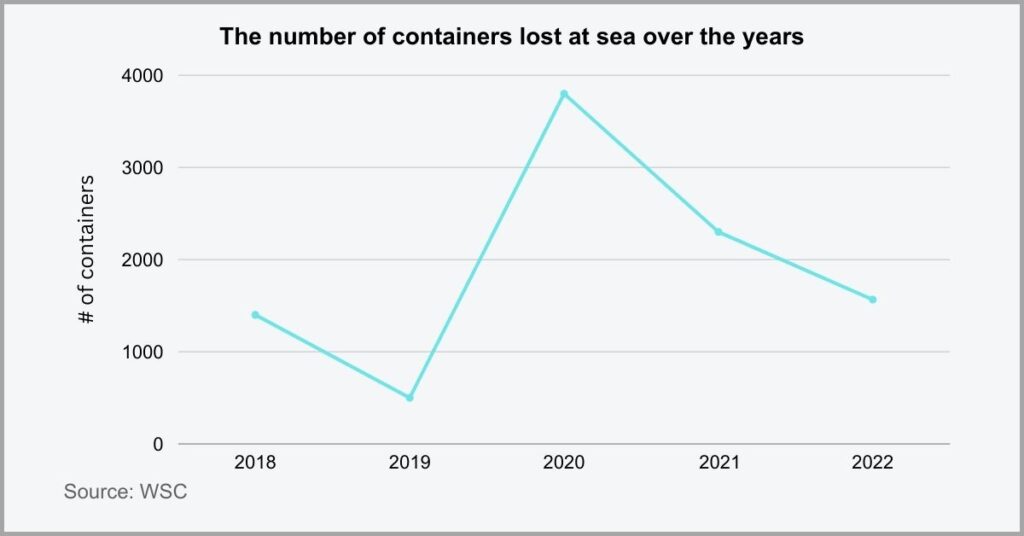
In this guide to transloading vs intermodal shipping, flexibility is, therefore, an essential differentiator.
With transloading, a single shipment may contain goods heading to multiple consignees who may have collaborated to order commodities from a single manufacturer so you’ll need to perform freight deconsolidation.
This is why you may see transloaders open a container, process the inventory, reload cargo, and then perform truck to rail-to-truck transfers to be able to send cargo via truck for the last-mile delivery.
Alternatively, transloading may also involve freight consolidation, where you’ll combine cargo headed to the same destination so they can share transportation.
Once it reaches this location, you can then deconsolidate the cargo as needed. This creates a more flexible shipping strategy that can save you time and money.
3. Cargo type
There are also key differences in cargo.
In intermodal shipping, you’ll notice that the cargo mostly involves large, dry bulk shipments, and, in some cases, ISO containers come into play for shipping various liquid commodities.
Overall, freight like ISO containers, for example, are designed to carry specific types of cargo, and this can restrict multi-commodity handling.
A study by Statista shows container freight rates of $5,868 in 2024, representing a 300% increase from 2023. This means that if you split up cargo due to intermodal’s inflexibility, you’ll need to use more costly containers.
That being said, intermodal shipping can still be a more suitable solution for shipping certain types of cargo like department store stock, where you need to keep the commodities in the same container.
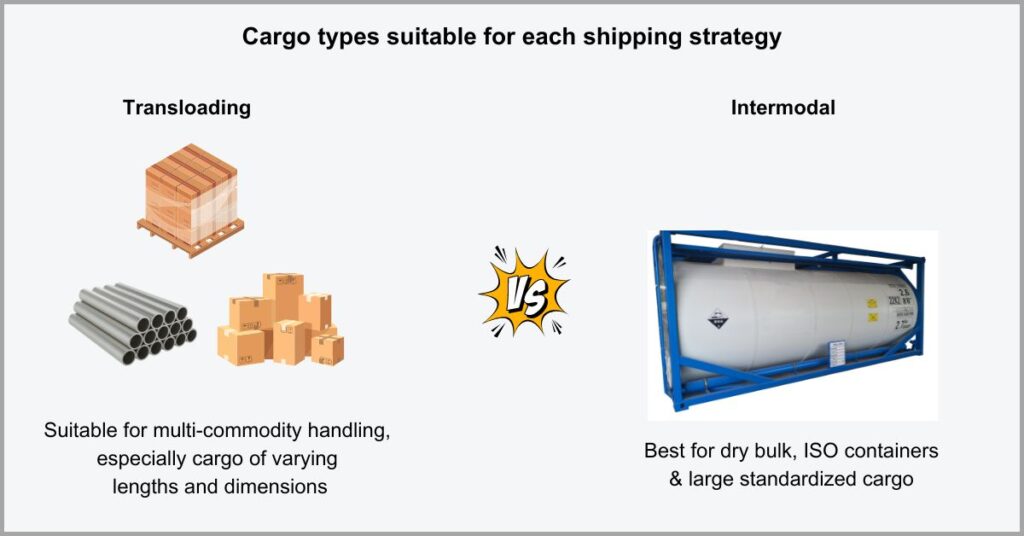
So what types of cargo are involved in transloading?
You may still ship the same types of cargo in transloading as you would in intermodal. However, it’s more versatile as it enables multi-commodity handling, making it more suitable for products like steel beams, palletized goods, and even household items.
That said, if you’re starting a transloading business and are trying to figure out what it all entails, you can lean on the experience and expertise of transloads.co.
Click here to get our premium support services which entail yard setup, operational optimization, and marketing, just to name a few.
We can help you get your new yard up and running efficiently, give you the operational intelligence to improve productivity, and even help you attract more business.
4. Contracts & logistics
Significant differences also arise in terms of contracts.
In intermodal shipping, there are multiple contracts involved. You’ll sign contracts with several carriers who take charge at different points of the shipping process, although the shipment typically belongs to just one consignee.
Therefore, with intermodal shipping, you’ll have to deal with a lot more contracts and logistics resulting from partnering with multiple carriers.
A survey by 3PL Study revealed that up to 66% of shippers struggle with logistics management, which sharply inflates their cost of transportation. One of the top reasons for the struggle is having to partner with multiple carriers across supply chains.
This, in turn, creates a very complex web of logistics, slowing down various business processes while making it difficult to optimize transportation routes.
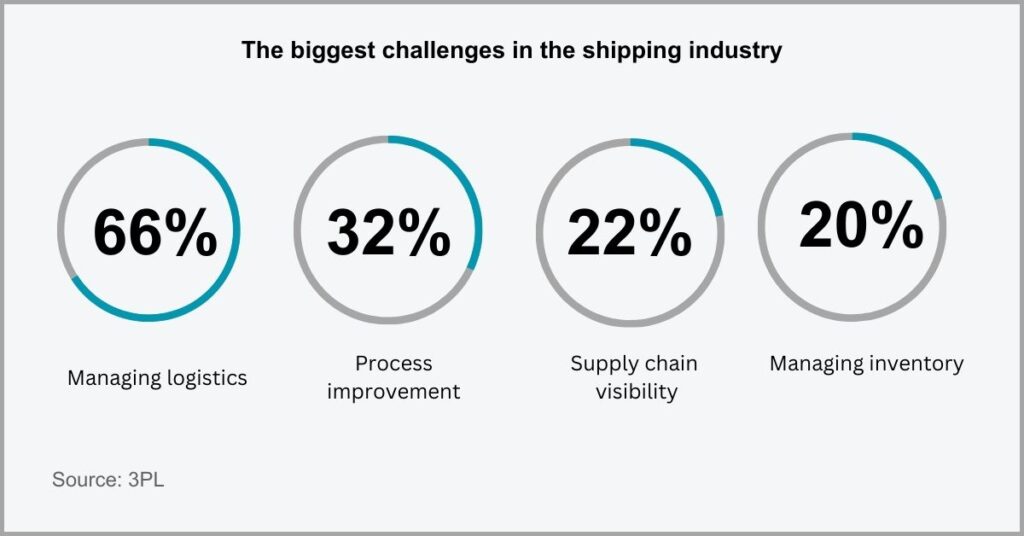
In the transloading business industry, transloading may be part of either one of two common shipping strategies.
First, you can choose to partner with a single carrier who handles the entire shipping process although they may subcontract transloading activities to third parties like a transload yard.
This facility will carry out the transloading as your carrier transitions from one form of transportation to another. However, they’ll still be in charge of the coordination and logistics, so this means less work for you
It may also bring in multiple carriers into the shipping process, while it also typically involves shipping and transferring goods belonging to multiple consignees.
So when it comes to transloading vs intermodal, intermodal strictly involves multiple carriers and one consignee whereas transloading may involve just a single carrier or multiple consignees.
5. Environmental impact
So which is the more environmentally friendly solution?
Well, in intermodal shipping, the container remains closed and is transferred as is, typically using a crane. This means there’s less use of equipment like forklifts since there’s no need to handle the goods inside the container.
As a result, intermodal shipping can reduce your business’s carbon footprint, and it may therefore be a more eco-friendly option compared to transloading.
In a 2024 survey by Breakthrough, 33% of transportation leaders rate environmental friendliness as their biggest hurdle. It is however a key priority given the massive role that the shipping industry plays in global warming.
That said, intermodal shipping still contributes to pollution, more so if it relies on inefficient shipping routes that cause delays, and therefore more carbon emissions.
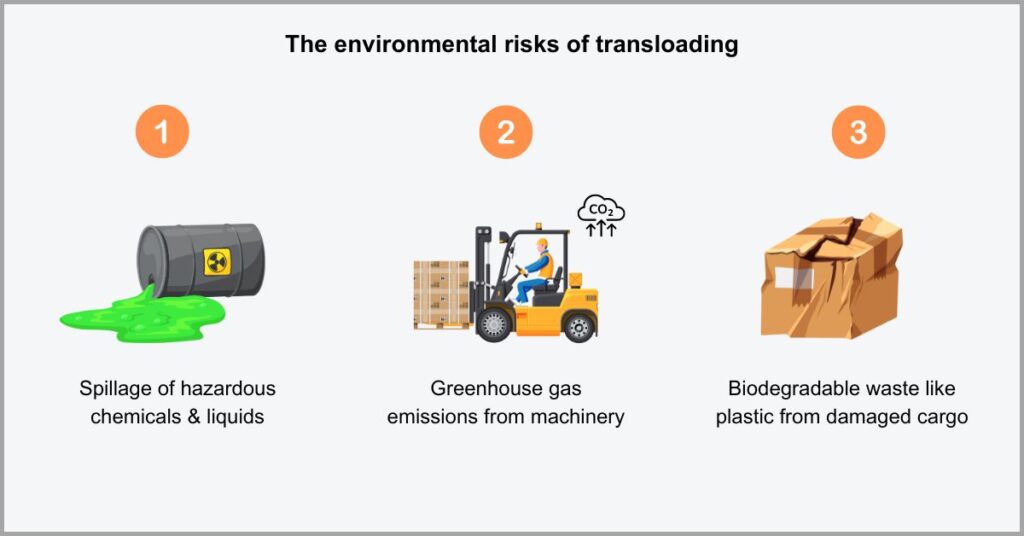
Transloading may be less eco-friendly than intermodal.
This largely boils down to the fact that it involves the use of various goods handling equipment that can increase greenhouse gas emissions. There’s also the risk of spillage of chemicals and hazardous materials that can also go on to cause pollution.
In either intermodal or transloading situations, having great quality data and process visibility is key to ensuring eco-friendliness.
Click here to check out important features of transloading software to learn how it can help you reduce your carbon footprint and become more eco-friendly.
Our platform can digitize your documents, thereby enabling your business to reduce paperwork, and the effects they have on the environment. In addition, it can help you handle transloading operations more efficiently and accurately.
6. Risk and reliability
Intermodal shipping offers great security.
That’s because the only time your goods are physically handled are during the initial loading stage. Afterward, the contents of the container remain sealed until the end.
So intermodal shipping greatly reduces the risk of freight damage and theft by minimizing the handling of goods to ensure fewer points of physical contact.
In fact, more than 75% of cargo losses are down to damages, with theft accounting for the remainder, according to a study by Allianz. It’s therefore clear that freight damage and theft are significant concerns during the shipping process.
That being said, you can still lose an entire cargo at sea. This calls for proper securing of containers and avoiding overloading containers, both of which are key contributors.
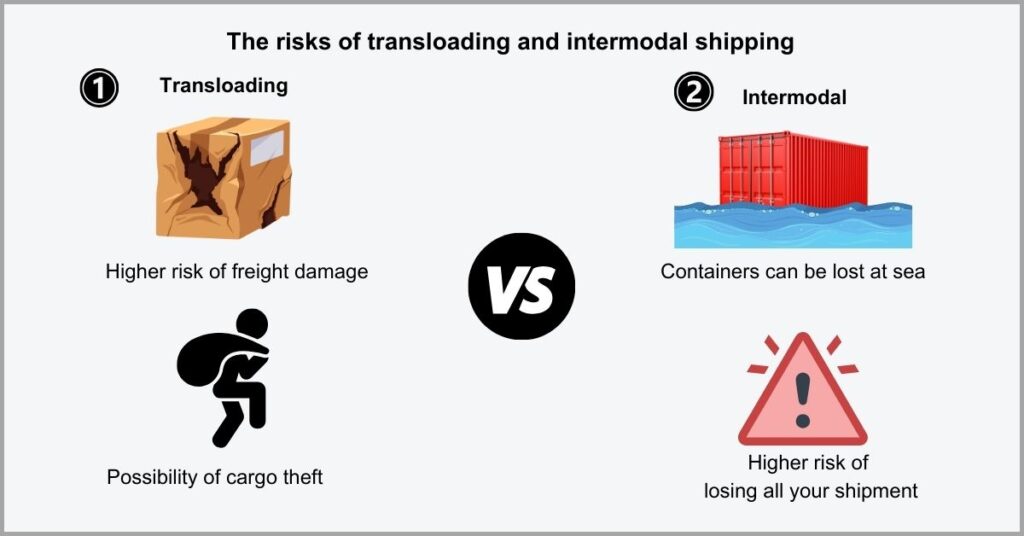
So how does transloading introduce security risks?
During transloading, your goods are transferred, unloaded, and perhaps even stored awaiting transportation. These activities require the meticulous attention of dock workers and transload operators, but there’s room for human error.
Cargo breakage can occur as workers forklift commodities between transportation methods, while theft by unscrupulous yard staff is still a possibility.
This is why it’s important to choose a great transloading software, which can help you monitor operations in real-time and share safety manuals for staff to follow. Consequently, you can ensure staff handle goods appropriately to avoid damage.
With an excellent solution like transloads.co, you also get a digital checklist that enables you to inspect cargo & document initial & final conditions in case of damage disputes.
7. Equipment Used
What kinds of equipment are involved in intermodal shipping?
In an intermodal facility, you’ll find equipment generally dedicated to lifting shipping containers like cranes or intermodal ramps. It also typically has a larger storage yard that you can use to store containers before transfers.
Overall, the equipment in intermodal facilities is geared toward handling containers, rather than enabling the flow of individual goods.
Intermodal containers have an average 65% utilization rate annually in the US, according to a Flexport study. So it may not be an ideal way of shipping if you’re looking to source small amounts of cargo.
However, If you’re shipping large cargo over long distances like overseas and achieve optimal container utilization of say 95%, then it can be an excellent shipping strategy.
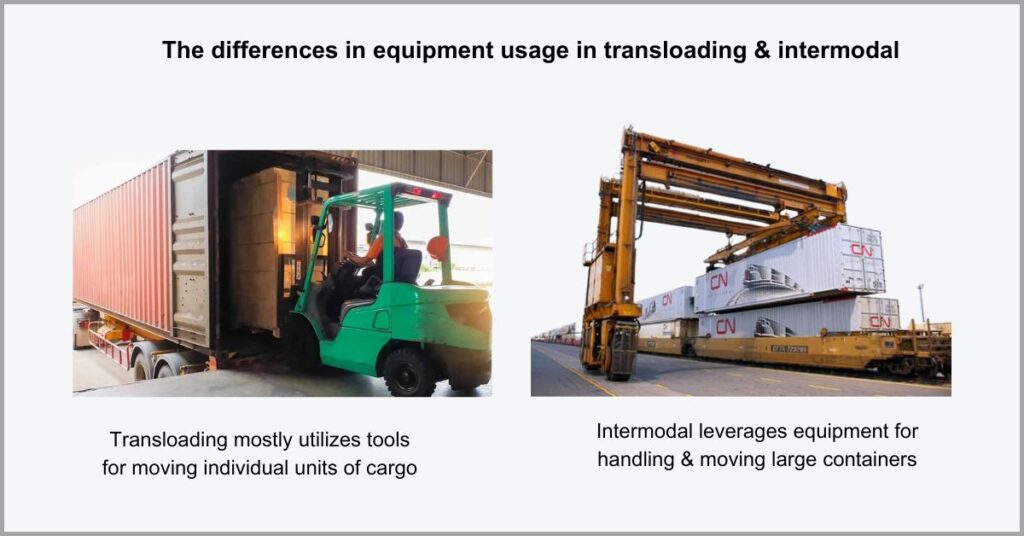
When it comes to the transloading vs intermodal discussion in terms of equipment, you’re likely to find the same tools in both facilities. This includes machinery like forklifts, reach stackers, and cranes, among others.
These pieces of equipment help move cargo from truck to rail to truck, but the key difference is that you’ll find tools that are suitable for enabling the flow of individual units of goods from shipments rather than an entire container.
That said, your typical transload facility may have tools that intermodal facilities lack.
For example, they may have conveyor belts to help transload sand, agricultural commodities like grain, and other products to minimize spillage.
It’s also likely that a transload facility will have a special pump for transferring liquid commodities between containers while an intermodal facility may not.
8. Costs and pricing structure
There are different cost factors to consider in each case.
Typically, in an intermodal setting, you may have more cost factors to deal with, because this also incorporates carriers’ fees as well as the cost of storing and transferring containers.
It’s also possible for intermodal to attract higher costs than transloading, especially if it involves switching goods to and from ocean vessels.
In fact, intermodal shipping can be 56% more expensive than road-only transloading, according to a study by the ECA. So, for the most part, it’s a more expensive process.
That being said, intermodal shipping can be cheaper over long distances. If you were ordering stock items for your office, for example, intermodal can be more cost-efficient. It’ll attract fewer handling expenses since the container remains sealed.
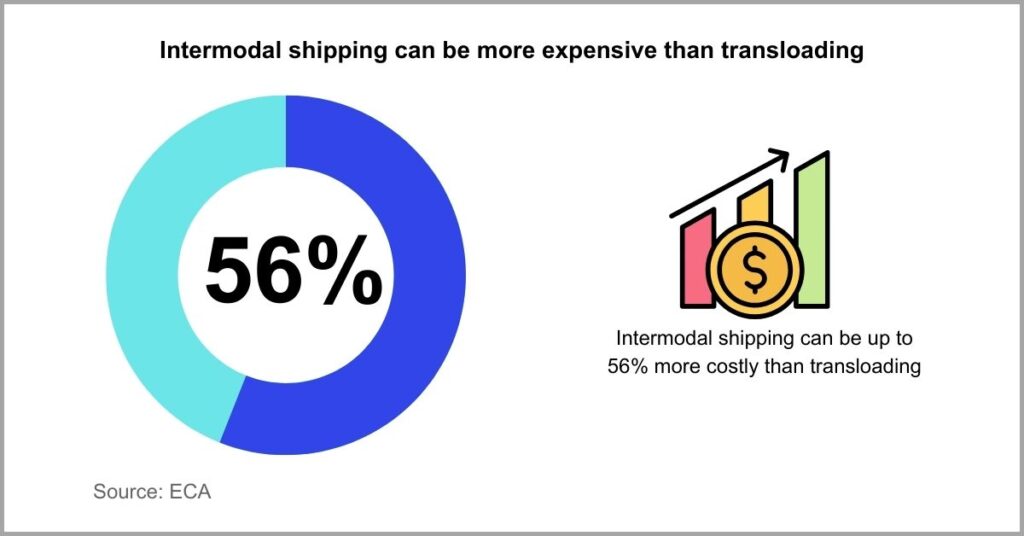
What about the cost factors in transloading?
Well, transloading deals with the loading and unloading of cargo, which typically happens at a much smaller scale compared to intermodal shipping.
This naturally means you get better ROI with transloading as a result.
It’s also important to note that transloading also attracts unique costs that you may not incur with intermodal shipping.
For instance, since individual goods are loaded from one mode of transportation to another, there may be additional handling and storage costs for you to deal with.
In some cases, transloading tends to be the most cost-effective solution for businesses. It enables you to combine shipments with multiple other consignees so that you can share the same transportation and split costs.
9. Speed and efficiency
How long does intermodal shipping take?
The length of intermodal shipping depends on very many factors, including the length of the distance you need to cover & modes of transportation used. However, there tend to be more delays, because of the paperwork involved in clearing containers.
So intermodal shipping may take longer, more so compared to truckload transloading, also partly because of port congestion & more complex logistics.
A study by the Beacon indicated a 60% increase in port congestion between May and June 2024. This backlog has greatly disrupted intermodal shipping, causing delays that stretch back several weeks.
Intermodal shipping is typically very rigid since you have to ship containers as without opening them up, and this can make it more prone to delays if a suitable means of transportation is unavailable.
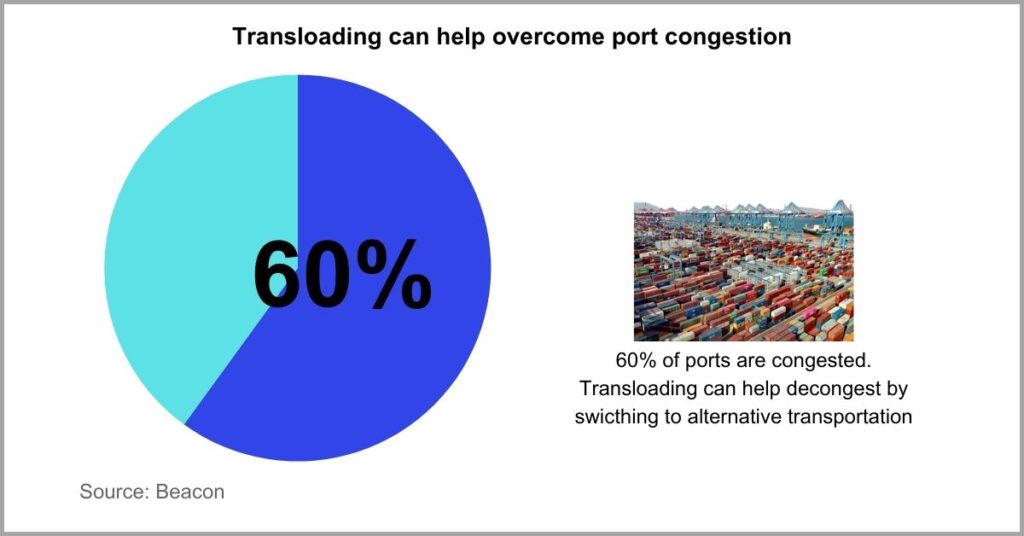
When it comes down to transloading vs intermodal in terms of speed, there are instances where transloading can be faster.
Instead of waiting for one mode of transportation to become available that can handle a massive container freight transfer, you can split shipments into smaller cargo.
You can then ship cargo from truck to rail and reconcile it later at a transload facility for the remainder of the journey.
This way, you can get around port congestion and other challenges of relying on a particular method of transportation. By helping to reduce delays between transport modes, transloading shipping can therefore be faster.
That said, there are instances when transloading can be slower because you have to load and unload cargo from containers, unlike in intermodal shipping.
10. Regulatory compliance
Intermodal shipping has its compliance headaches.
With this type of shipping often reeling in freight forwarding companies and many other supply chain partners, there are various regulatory factors at play for your business that increase the risk of sanctions, fines, and other penalties.
Typically, intermodal shipping involves larger shipping networks, which naturally attracts more environmental, safety, and customs regulations.
A Lloyd’s List survey revealed that 45% of respondents cited regulatory risk as the biggest challenge to the shipping industry. These concerns revolved around environmental laws, worker safety, and managing carbon emissions, among others.
With a great yard management solution, both intermodal shippers and transloaders can unearth shipping intelligence. It can help you train employees on workplace safety and monitor operations in real-time to streamline compliance bottlenecks.
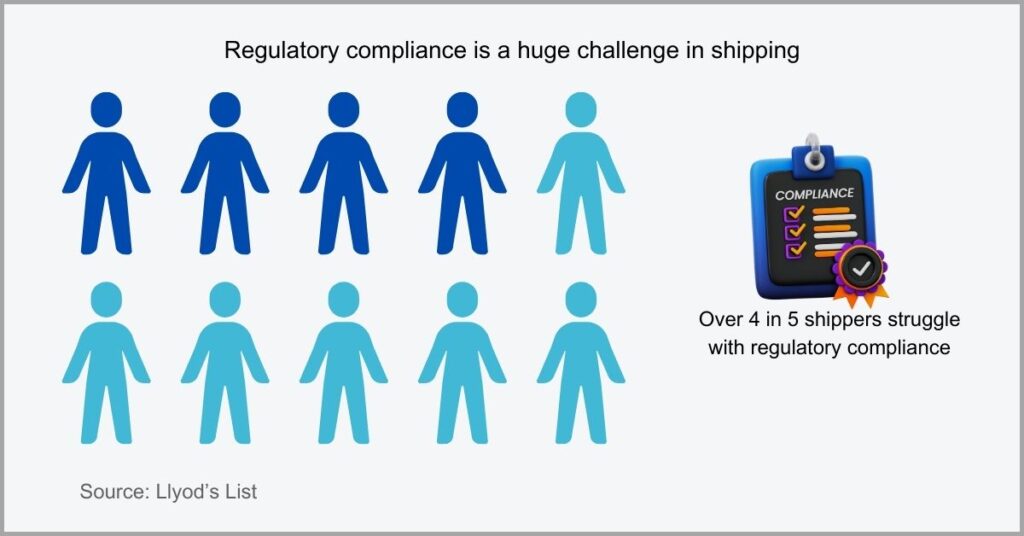
But what about compliance challenges in transloading?
For the most part, transloading involves shipping on a domestic scale, and therefore there may be fewer environmental and regulatory requirements to consider.
Both intermodal and transload businesses, however, will need to ensure compliance with federal laws like those set by the US Environmental Protection Agency.
So you’ll need to perform proper yard location management either way.
This entails ensuring that you follow the right waste management procedures, observe worker safety best practices as described by OSHA, and monitor emission levels to ensure they are within acceptable thresholds.
You’ll also need to ensure that equipment and how you handle different commodities are in line with requirements by federal, state, and, if applicable, international policies.
Conclusion
Transloading vs intermodal, which is right for you?
It’s important to understand what each shipping strategy brings to the table.
Otherwise, if you go with a shipping strategy that’s a misfit for your needs, this can mean significantly higher shipping expenses for your business.
A study by UNCTAD revealed an 11% annual increase in shipping costs for businesses. It proves the need to adopt agile shipping practices that can help you save money.
If you have a shipment heading out to multiple destinations, transloading offers great flexibility. Meanwhile, intermodal provides more secure shipping and fewer handling risks if you’re transporting shipment to a single consignee.
Be sure to explore transloads.co now if you’d like to learn more about transloading and the solutions we offer.
From transloading support services to a top-notch transload management system, we can help you improve your shipping and transloading processes to boost productivity.

